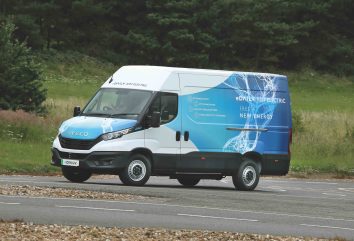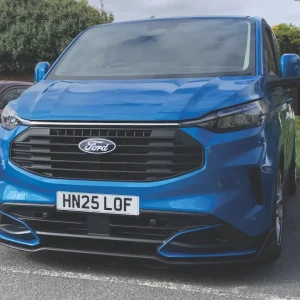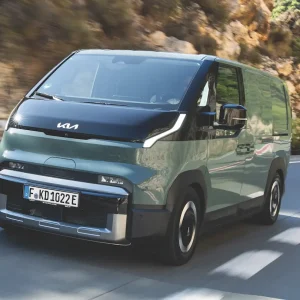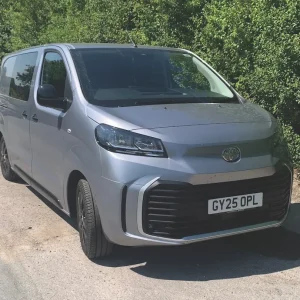
If you’re looking to switch to electric light commercials, then do not make the mistake of depending solely on the woefully-inadequate public charging infrastructure. Get your own charging points installed instead.
That’s the message from leading electric vans consultant Paul Kirby of EV Essentials. “Avoid the public network and charge in the workplace,” he advises.
Speaking at the press launch of the electric Iveco eDaily at the Millbrook Proving Ground in Bedfordshire, he pointed to the poor reliability of public charging points, explaining that the parking spaces allocated to them are invariably too small to accommodate large panel vans, and the charges for the electricity they dispense can be eye-wateringly high.
Public charging can cost up to 79p per kWh, compared with as little as 8p per kWh if you plug in at home.
Now on the market in the UK, the eDaily portfolio of vans, chassis cabs and crew cabs grosses from 3.5 to 7.2-tonnes and neatly mirrors the diesel line-up.
It includes the 42S, a 4.25-tonner, which can be driven on a car driver’s licence as a special concession.
Any car driver who passed their test after 1 January 1997 is not usually allowed to drive anything heavier than a 3.5-tonner. The idea of the 42S is to help firms that are willing to go zero-emission, but want more payload capacity than an electric 3.5-tonner can deliver, and do not want the car licence holders they employ to be obliged to take an additional test.
Any driver allocated a 42S will be compelled to undergo five hours of specialist training, however. Other limitations include a heavy-truck-style requirement for an MoT test every 12 months from the date of first registration.
Maximum van load volume is a whopping 19.6m3. The chassis cab has a flat chassis with the same mounting points as the diesel model, which Iveco says should make it easier to mount bodies.
The manufacturer has accredited over 20 bodybuilders to work on the vehicle, including well-known names such as Paneltex, Tipmaster, TGS and Alloy Bodies. As a consequence, it can be supplied bodied as everything from a tipper or a dropside, to a curtainsider or a traffic management vehicle.
Operators can select models with one, two or three battery packs offering 37kWh, 74kWh and 111kWh respectively, with claimed ranges extending from 68 to 186 miles, according to the WLTP combined cycle. Iveco claims an eDaily 42S with three batteries can achieve up to 248 miles on the urban cycle fully-laden.
Opt for two batteries on a 3.5-tonne van and your maximum gross payload is 1,100kg. Opt for three on a 4.25-tonne van and your top gross payload is 1,415kg; hence the attraction of the 42S.
Batteries can be added during a vehicle’s life if the operator’s requirements change. The exercise takes around two hours.
Take a battery out and you boost your payload capability by 270kg.
Depending on the charging facilities you are using you should be able to boost the range by 62 miles in half-an-hour. To help preserve the range, the vehicle can be brought to the right cabin temperature prior to departure in the morning while still connected to the charging socket.
Power comes courtesy of a 140kW motor delivering 400Nm of torque.
Three regenerative modes are available and the system’s ability to act as a retarder means that one-pedal-driving is an option. When you need to slow down, all you have to do is lift your foot off the accelerator pedal with no need to touch the brake pedal – unless there is an emergency.
Three drive modes – eco, natural and power – can be called on. A hefty power boost can be triggered thanks to the vehicle’s Hi-Power function if you need to climb a steep hill while heavily laden, and eDaily can stop then pull away again on a 30º incline.
The eDaily has a towing capacity of up to 3.5 tonnes. A massive 153.58-tonne load was recently hauled by a standard eDaily 3.5-tonner in a publicity stunt at Blackbushe Airport in Surrey, winning it the Guinness World Records title for ‘heaviest weight towed by an electric van’.
Also worth noting is eDaily’s surprisingly-tight turning radius of from 5.5m kerb-to-kerb. Pressing the standard ‘city steering’ button gives you extra power assistance if you are manoeuvring in and out of tight spaces.
Three different electric power take offs (ePTOs) are available with an output of up to 15kW and they can be used even when the motor is switched off.
As with most electric vans, the ranges cited above mean drivers will have no option but to plug into a public charging point if they are on a long-haul intercity run. Most light commercials tend to be used locally however, the manufacturer points out.
If you need more range on a regular basis and want to be zero-emission then remember that Iveco and Hyundai jointly unveiled a prototype Daily equipped with the latter’s fuel cell technology at last year’s IAA Transportation show in Hanover, Germany. As yet, there is no indication as to when or whether it will go on sale though.
A variety of standard and optional connectivity-enabled services are provided with eDaily through the ‘Iveco On’ portal, with software updated over the air and predictive diagnostics hopefully preventing faults leading to unscheduled halts. The services include the eDaily Routing app, which predicts the vehicle’s range, how much charge will be required for it to reach its destination and the time of arrival.
The eDaily is protected by a three-year/100,000-mile warranty, with the battery covered for eight years/100,000 miles if you opt for one, or eight years/155,000 miles if you opt for two or three.
Electric vans are significantly more expensive to acquire than their diesel counterparts, but maintenance costs are up to 25% lower than they are for equivalent diesels, Iveco contends.
Furthermore, it is rolling out a long-term rental package called GATE, short for green and advanced transport ecosystem, that it says should make the expense manageable for significant numbers of customers.
Returning to the importance of businesses installing their own charging facilities, Pod Point has become Iveco’s preferred charging point supplier. When fleets acquire a new eDaily, then Iveco will recommend Pod Point as their charging partner.
Pod Point is offering AC charging from 7kW up to 22kW using either its Solo 3 or Twin charger at a discounted price. That is a welcome initiative given how much such installations can cost, although government grants of up to £350 per socket for up to 40 sockets per company are available.
The firm can sort out any groundworks required and arrange for the charging units to be maintained.
Worth noting too is the availability of Array Charging, Pod Point’s load balancing package, which allows more chargers to be installed while still using the existing electricity supply. Iveco is also offering retail customers a free Solo 3 home charger and installation.
Getting workplace charging installed requires a good deal of planning, warns Paul Kirby. Considerations include everything from whether you have the space to put in all the charging points you need, and whether any of them should be rapid chargers, to whether the power they draw will affect the heating and lighting in your premises.
Iveco Capital can help fund the cost of installing the charging infrastructure, and contract hire and low-rate HP deals have been constructed to help customers acquire the vehicles.
Recognising that some clients will have no option but to use public charging points, Iveco has introduced a charge card that can be used at over 9,000 of them.
Order an eDaily today and you can expect delivery before the end of the year. Order a diesel Daily and you may have to wait until the first quarter of 2024 before it arrives.
While the need to turn an old-fashioned ignition key once and then once again to start the vehicle off – rather than using a key fob and pushing a button – seems a little dated, eDaily feels like an effective performer.
Putting it through its paces at Millbrook left us impressed with its manoeuvrability when we pushed the ‘city steering’ button, and its ability to accelerate strongly when necessary, thanks to Hi-Power. The standard hill descent function allows you to go down inclines in a controlled manner, while making full use of the regeneration function when appropriate means you can get from A to B without worrying about the brake pedal.
What became increasingly clear, though, is that drivers will need proper training to get the best out of the vehicle and maximise its range. Simply handing someone the keys as one might with a diesel and expecting them to get on with it is no longer an option; if indeed it ever really was.
Iveco eDaily H2 3520 3.5-tonne van
Price (ex VAT, inc. PIVG) £74,480
Price range (ex VAT, inc PIVG) £55,750 –103,320
Insurance group TBC
Warranty 3 years, 100,000mls – batteries: 8 years/ 155,000mls
Service intervals 2 years/50,000mls
Load length 3,130mm
Load width 1,740mm
Load bay height 1,900mm
Gross payload 986kg
Load volume 10.8m3
Engine size/power 188hp 140kW electric motor
Range 146mls
CO2 0g/km





